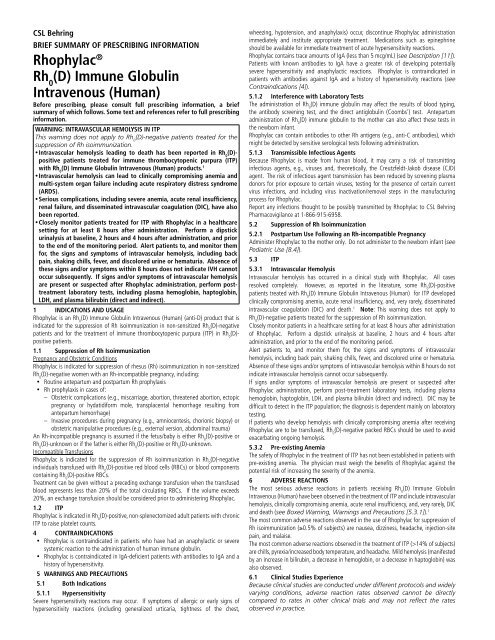media - ASD Healthcare
media - ASD Healthcare
media - ASD Healthcare
You also want an ePaper? Increase the reach of your titles
YUMPU automatically turns print PDFs into web optimized ePapers that Google loves.
CSL BehringBRIEF SUMMARY OF PRESCRIBING INFORMATIONRhophylac ®Rh 0(D) Immune GlobulinIntravenous (Human)Before prescribing, please consult full prescribing information, a briefsummary of which follows. Some text and references refer to full prescribinginformation.WARNING: INTRAVASCULAR HEMOLYSIS IN ITPThis warning does not apply to Rh 0(D)-negative patients treated for thesuppression of Rh isoimmunization.• Intravascular hemolysis leading to death has been reported in Rh 0(D)-positive patients treated for immune thrombocytopenic purpura (ITP)with Rh 0(D) Immune Globulin Intravenous (Human) products. 1• Intravascular hemolysis can lead to clinically compromising anemia andmulti-system organ failure including acute respiratory distress syndrome(ARDS).• Serious complications, including severe anemia, acute renal insufficiency,renal failure, and disseminated intravascular coagulation (DIC), have alsobeen reported.• Closely monitor patients treated for ITP with Rhophylac in a healthcaresetting for at least 8 hours after administration. Perform a dipstickurinalysis at baseline, 2 hours and 4 hours after administration, and priorto the end of the monitoring period. Alert patients to, and monitor themfor, the signs and symptoms of intravascular hemolysis, including backpain, shaking chills, fever, and discolored urine or hematuria. Absence ofthese signs and/or symptoms within 8 hours does not indicate IVH cannotoccur subsequently. If signs and/or symptoms of intravascular hemolysisare present or suspected after Rhophylac administration, perform posttreatmentlaboratory tests, including plasma hemoglobin, haptoglobin,LDH, and plasma bilirubin (direct and indirect).1 INDICATIONS AND USAGERhophylac is an Rh 0(D) Immune Globulin Intravenous (Human) (anti-D) product that isindicated for the suppression of Rh isoimmunization in non-sensitized Rh 0(D)-negativepatients and for the treatment of immune thrombocytopenic purpura (ITP) in Rh 0(D)-positive patients.1.1 Suppression of Rh IsoimmunizationPregnancy and Obstetric ConditionsRhophylac is indicated for suppression of rhesus (Rh) isoimmunization in non-sensitizedRh 0(D)-negative women with an Rh-incompatible pregnancy, including:• Routine antepartum and postpartum Rh prophylaxis• Rh prophylaxis in cases of:– Obstetric complications (e.g., miscarriage, abortion, threatened abortion, ectopicpregnancy or hydatidiform mole, transplacental hemorrhage resulting fromantepartum hemorrhage)– Invasive procedures during pregnancy (e.g., amniocentesis, chorionic biopsy) orobstetric manipulative procedures (e.g., external version, abdominal trauma)An Rh-incompatible pregnancy is assumed if the fetus/baby is either Rh 0(D)-positive orRh 0(D)-unknown or if the father is either Rh 0(D)-positive or Rh 0(D)-unknown.Incompatible TransfusionsRhophylac is indicated for the suppression of Rh isoimmunization in Rh 0(D)-negativeindividuals transfused with Rh 0(D)-positive red blood cells (RBCs) or blood componentscontaining Rh 0(D)-positive RBCs.Treatment can be given without a preceding exchange transfusion when the transfusedblood represents less than 20% of the total circulating RBCs. If the volume exceeds20%, an exchange transfusion should be considered prior to administering Rhophylac.1.2 ITPRhophylac is indicated in Rh 0(D)-positive, non-splenectomized adult patients with chronicITP to raise platelet counts.4 CONTRAINDICATIONS• Rhophylac is contraindicated in patients who have had an anaphylactic or severesystemic reaction to the administration of human immune globulin.• Rhophylac is contraindicated in IgA-deficient patients with antibodies to IgA and ahistory of hypersensitivity.5 WARNINGS AND PRECAUTIONS5.1 Both Indications5.1.1 HypersensitivitySevere hypersensitivity reactions may occur. If symptoms of allergic or early signs ofhypersensitivity reactions (including generalized urticaria, tightness of the chest,wheezing, hypotension, and anaphylaxis) occur, discontinue Rhophylac administrationim<strong>media</strong>tely and institute appropriate treatment. Medications such as epinephrineshould be available for im<strong>media</strong>te treatment of acute hypersensitivity reactions.Rhophylac contains trace amounts of IgA (less than 5 mcg/mL) (see Description [11]).Patients with known antibodies to IgA have a greater risk of developing potentiallysevere hypersensitivity and anaphylactic reactions. Rhophylac is contraindicated inpatients with antibodies against IgA and a history of hypersensitivity reactions (seeContraindications [4]).5.1.2 Interference with Laboratory TestsThe administration of Rh 0(D) immune globulin may affect the results of blood typing,the antibody screening test, and the direct antiglobulin (Coombs’) test. Antepartumadministration of Rh 0(D) immune globulin to the mother can also affect these tests inthe newborn infant.Rhophylac can contain antibodies to other Rh antigens (e.g., anti-C antibodies), whichmight be detected by sensitive serological tests following administration.5.1.3 Transmissible Infectious AgentsBecause Rhophylac is made from human blood, it may carry a risk of transmittinginfectious agents, e.g., viruses and, theoretically, the Creutzfeldt-Jakob disease (CJD)agent. The risk of infectious agent transmission has been reduced by screening plasmadonors for prior exposure to certain viruses, testing for the presence of certain currentvirus infections, and including virus inactivation/removal steps in the manufacturingprocess for Rhophylac.Report any infections thought to be possibly transmitted by Rhophylac to CSL BehringPharmacovigilance at 1-866-915-6958.5.2 Suppression of Rh Isoimmunization5.2.1 Postpartum Use Following an Rh-incompatible PregnancyAdminister Rhophylac to the mother only. Do not administer to the newborn infant (seePediatric Use [8.4]).5.3 ITP5.3.1 Intravascular HemolysisIntravascular hemolysis has occurred in a clinical study with Rhophylac. All casesresolved completely. However, as reported in the literature, some Rh 0(D)-positivepatients treated with Rh 0(D) Immune Globulin Intravenous (Human) for ITP developedclinically compromising anemia, acute renal insufficiency, and, very rarely, disseminatedintravascular coagulation (DIC) and death. 1 Note: This warning does not apply toRh 0(D)-negative patients treated for the suppression of Rh isoimmunization.Closely monitor patients in a healthcare setting for at least 8 hours after administrationof Rhophylac. Perform a dipstick urinalysis at baseline, 2 hours and 4 hours afteradministration, and prior to the end of the monitoring period.Alert patients to, and monitor them for, the signs and symptoms of intravascularhemolysis, including back pain, shaking chills, fever, and discolored urine or hematuria.Absence of these signs and/or symptoms of intravascular hemolysis within 8 hours do notindicate intravascular hemolysis cannot occur subsequently.If signs and/or symptoms of intravascular hemolysis are present or suspected afterRhophylac administration, perform post-treatment laboratory tests, including plasmahemoglobin, haptoglobin, LDH, and plasma bilirubin (direct and indirect). DIC may bedifficult to detect in the ITP population; the diagnosis is dependent mainly on laboratorytesting.If patients who develop hemolysis with clinically compromising anemia after receivingRhophylac are to be transfused, Rh 0(D)-negative packed RBCs should be used to avoidexacerbating ongoing hemolysis.5.3.2 Pre-existing AnemiaThe safety of Rhophylac in the treatment of ITP has not been established in patients withpre-existing anemia. The physician must weigh the benefits of Rhophylac against thepotential risk of increasing the severity of the anemia.6 ADVERSE REACTIONSThe most serious adverse reactions in patients receiving Rh 0(D) Immune GlobulinIntravenous (Human) have been observed in the treatment of ITP and include intravascularhemolysis, clinically compromising anemia, acute renal insufficiency, and, very rarely, DICand death (see Boxed Warning, Warnings and Precautions [5.3.1]). 1The most common adverse reactions observed in the use of Rhophylac for suppression ofRh isoimmunization (≥0.5% of subjects) are nausea, dizziness, headache, injection-sitepain, and malaise.The most common adverse reactions observed in the treatment of ITP (>14% of subjects)are chills, pyrexia/increased body temperature, and headache. Mild hemolysis (manifestedby an increase in bilirubin, a decrease in hemoglobin, or a decrease in haptoglobin) wasalso observed.6.1 Clinical Studies ExperienceBecause clinical studies are conducted under different protocols and widelyvarying conditions, adverse reaction rates observed cannot be directlycompared to rates in other clinical trials and may not reflect the ratesobserved in practice.42 InsideOut






